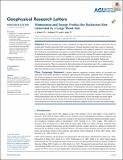Momentum and Energy Predict the Backwater Rise Generated by a Large Wood Jam
Author(s)
Follett, E.; Schalko, Isabella; Nepf, Heidi
Download2020GL089346.pdf (4.066Mb)
Publisher with Creative Commons License
Publisher with Creative Commons License
Creative Commons Attribution
Terms of use
Metadata
Show full item recordAbstract
Wood reintroduction is now considered an important aspect of stream restoration, due to ecohydraulic benefits associated with wood presence. Channel‐spanning wood jams create an upstream backwater, increasing flow heterogeneity, sediment deposition, and ecological productivity, but also flood risk. Backwater rise prediction is necessary to evaluate flood hazards in hydraulic models, improve design of engineered logjam projects, and compare jam effects across river systems. We present experimental results demonstrating that a jam can be modeled as a porous obstruction generating momentum loss proportional to the number, size, and packing density of the logs and the jam length. Energy and momentumconstraints are combined to predict backwater rise from unit discharge and a dimensionless structural parameter. This novel approach allows description of preexisting jams with a common metric. The model was used to demonstrate how backwater length, pool size, and upstream sediment deposition depend on jam structure and channel slope.
Date issued
2020-08Department
Massachusetts Institute of Technology. Department of Civil and Environmental EngineeringJournal
Geophysical Research Letters
Publisher
American Geophysical Union (AGU)
Citation
Follett, E. et al. "Momentum and Energy Predict the Backwater Rise Generated by a Large Wood Jam." Geophysical Research Letters 47, 17 (September 2020): e2020GL089346. © 2020 The Authors.
Version: Final published version
ISSN
0094-8276
1944-8007